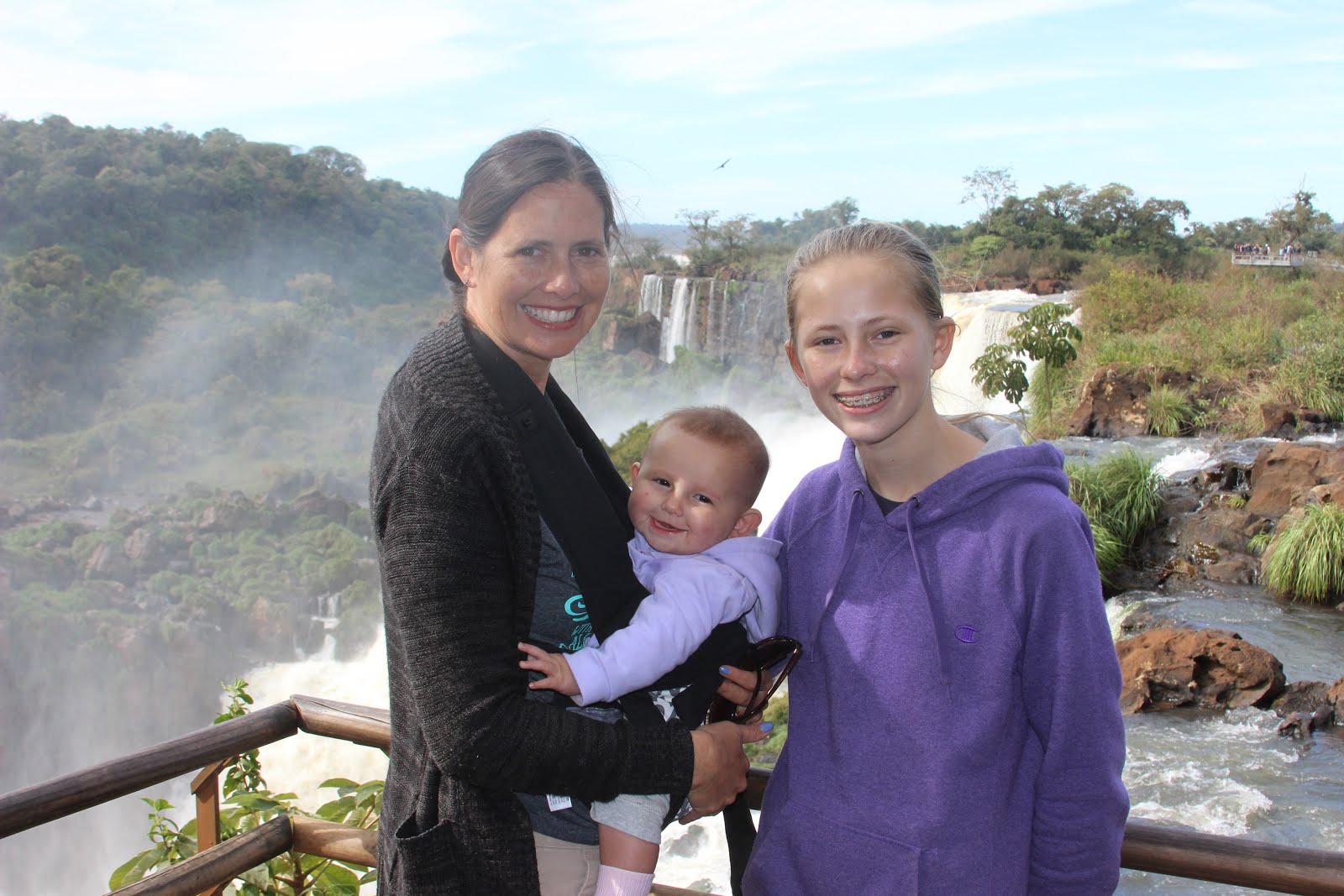Monday, June 22, 2009
ANIMISM
Tuesday, June 16, 2009
We left Tirol this morning at 9:00 and arrived in Yuty for lunch. Christie and Dan, our teammates, had prepared a great lunch and then after lunch they gave their testimonies. Christie then shared about a paper that she wrote recently for her missiology class entitled: Werewolves and Witchdoctors: Biblical Responses to Animism in Paraguay.
Here are a few paragraphs from her paper:
In the past few months I have counseled a young lady whose mother was putting black magic paraphernalia under her bed to get her to break up with her boyfriend. I’ve listened to a church leader describe being visited at night by a ghost. I’ve prayed for a teary friend on the eve of leaving her husband after her mother in law had cursed her marriage. I’ve studied the Bible with a depressed friend who was visiting a witch doctor. I’ve heard Christians tell me stories of their relatives and friends who were kidnapped by Jasy Jatere and Pombero, creatures that some Paraguayans dismiss as mythical beings. I’ve been given a plant that will ward off evil spirits if you plant it in front of your house. I was asked to pray for a husband who, as a result of a curse, had begun drinking excessively (his wife admitted that she came to our house because the witchdoctor was out of town.) I’ve seen babies with red thread tied around their wrist to ward off the evil eye. I’ve listened to my maid’s description of the werewolf that prowls late at night on her street. I’ve seen the crowds of people on their way to Palm Sunday mass, carrying palm branches that they’ll have blessed by the priest and hang in their house for protection against evil.
When asked what the dominant religion in Paraguay is, we commonly answer, “Roman Catholicism” and occasionally mention doctrines such as purgatory and virgin worship to illustrate some of the primary obstacles encountered. Yet the more we have learned about what most Paraguayans believe, the stronger we have found the trend toward a basically animistic world view and deeply ingrained syncretism rather than Christian monotheism. What does the Bible have to say about these animistic Paraguayan beliefs and traditions? Are they harmless folklore, an integral part of their culture that shouldn’t be changed, or are they tools of Satan used to keep people enslaved to fear and trusting in powers other than God? In this paper I will identify some animistic aspects of Paraguayan folklore, evaluate them according to human theories and biblical principles, and suggest Biblical responses that our church-planting team can use to help Paraguayans develop a Godly worldview.
Gailyn Van Rheenan, a Christian who has worked in animistic contexts, defines animism as
the belief that personal spiritual beings and impersonal spiritual forces have power over human affairs and, consequently, that human beings must discover what beings and forces are influencing them in order to determine future action and, frequently, to manipulate their power.
The many mythical beings in Paraguayan folklore come from Guarani Indian legends. One main legend tells of Tau, the evil spirit, who captured and married a beautiful Indian princess, Kerana. Their union produced seven monsters: Teju-Jagua, Mboi-Tui, Moñái, Yasy Jatere, Kurupi, Ao-Ao and Luisón. Several of these creatures are still feared by many Paraguayans today. Yasy Jatere is a small beautiful blond boy who whistles during siesta time to attract children whom he kidnaps. His victims eventually return home, crazy and unable to speak for a time, and are said to have seizures on the anniversary of their kidnapping. If seven consecutive sons are born into one family, the seventh is believed to be Luisón, a werewolf. On Tuesday and Friday nights he changes into creature that resembles a large black dog who “devours the flesh of the dead and the soul of the living.” If he licks a person’s forehead, passes under their legs, or bites them, they too become a Luisón and their family is unable to light a candle in their memory because their soul goes to hell. The Luisón can only be killed with a silver bullet that has been blessed by the priest.
Tau and Kerana’s children are not the only ones still feared by many Paraguayans. The Pombero (or “Man of the Night”) is a hairy, ugly dwarf who terrorizes people, kidnaps and impregnates young ladies, and seeks vengeance on those who do not leave him nightly gifts of whiskey and tobacco. Ghosts (Malavisión / Póra) are souls who haven’t gone to hell yet and are also feared. These ghosts are believed to stay near the place where they died (along the road, for example) or to haunt houses. Many Paraguayans tell of times they have seen ghosts and felt their cold touch in the night.
Of all the people of the world, animists are the most receptive to Christianity. This is good news for those of us working in animistic contexts, because it implies that the gospel directly addresses their felt needs. Animists live with an all-pervasive fear of spirits, magic and witchcraft, and the Bible teaches that “perfect love drives out fear” (I Jn. 4:18) and that Christ has triumphed over the principalities and powers (Col. 2:15). They fear disharmony and Christians show true harmony with God and man. The list goes on, but the point is clear. God offers animists the peace, power, and harmony that animists lack. Rather than laugh at their fears of werewolves, dismiss the effects of their curses, or condone their visits to witchdoctors, we must seek to understand the animistic aspects of their worldview and teach the Bible accordingly. May God use us to bring Paraguayans from the kingdom of darkness into his kingdom of light!
We left Tirol this morning at 9:00 and arrived in Yuty for lunch. Christie and Dan, our teammates, had prepared a great lunch and then after lunch they gave their testimonies. Christie then shared about a paper that she wrote recently for her missiology class entitled: Werewolves and Witchdoctors: Biblical Responses to Animism in Paraguay.
Here are a few paragraphs from her paper:
In the past few months I have counseled a young lady whose mother was putting black magic paraphernalia under her bed to get her to break up with her boyfriend. I’ve listened to a church leader describe being visited at night by a ghost. I’ve prayed for a teary friend on the eve of leaving her husband after her mother in law had cursed her marriage. I’ve studied the Bible with a depressed friend who was visiting a witch doctor. I’ve heard Christians tell me stories of their relatives and friends who were kidnapped by Jasy Jatere and Pombero, creatures that some Paraguayans dismiss as mythical beings. I’ve been given a plant that will ward off evil spirits if you plant it in front of your house. I was asked to pray for a husband who, as a result of a curse, had begun drinking excessively (his wife admitted that she came to our house because the witchdoctor was out of town.) I’ve seen babies with red thread tied around their wrist to ward off the evil eye. I’ve listened to my maid’s description of the werewolf that prowls late at night on her street. I’ve seen the crowds of people on their way to Palm Sunday mass, carrying palm branches that they’ll have blessed by the priest and hang in their house for protection against evil.
When asked what the dominant religion in Paraguay is, we commonly answer, “Roman Catholicism” and occasionally mention doctrines such as purgatory and virgin worship to illustrate some of the primary obstacles encountered. Yet the more we have learned about what most Paraguayans believe, the stronger we have found the trend toward a basically animistic world view and deeply ingrained syncretism rather than Christian monotheism. What does the Bible have to say about these animistic Paraguayan beliefs and traditions? Are they harmless folklore, an integral part of their culture that shouldn’t be changed, or are they tools of Satan used to keep people enslaved to fear and trusting in powers other than God? In this paper I will identify some animistic aspects of Paraguayan folklore, evaluate them according to human theories and biblical principles, and suggest Biblical responses that our church-planting team can use to help Paraguayans develop a Godly worldview.
Gailyn Van Rheenan, a Christian who has worked in animistic contexts, defines animism as
the belief that personal spiritual beings and impersonal spiritual forces have power over human affairs and, consequently, that human beings must discover what beings and forces are influencing them in order to determine future action and, frequently, to manipulate their power.
The many mythical beings in Paraguayan folklore come from Guarani Indian legends. One main legend tells of Tau, the evil spirit, who captured and married a beautiful Indian princess, Kerana. Their union produced seven monsters: Teju-Jagua, Mboi-Tui, Moñái, Yasy Jatere, Kurupi, Ao-Ao and Luisón. Several of these creatures are still feared by many Paraguayans today. Yasy Jatere is a small beautiful blond boy who whistles during siesta time to attract children whom he kidnaps. His victims eventually return home, crazy and unable to speak for a time, and are said to have seizures on the anniversary of their kidnapping. If seven consecutive sons are born into one family, the seventh is believed to be Luisón, a werewolf. On Tuesday and Friday nights he changes into creature that resembles a large black dog who “devours the flesh of the dead and the soul of the living.” If he licks a person’s forehead, passes under their legs, or bites them, they too become a Luisón and their family is unable to light a candle in their memory because their soul goes to hell. The Luisón can only be killed with a silver bullet that has been blessed by the priest.
Tau and Kerana’s children are not the only ones still feared by many Paraguayans. The Pombero (or “Man of the Night”) is a hairy, ugly dwarf who terrorizes people, kidnaps and impregnates young ladies, and seeks vengeance on those who do not leave him nightly gifts of whiskey and tobacco. Ghosts (Malavisión / Póra) are souls who haven’t gone to hell yet and are also feared. These ghosts are believed to stay near the place where they died (along the road, for example) or to haunt houses. Many Paraguayans tell of times they have seen ghosts and felt their cold touch in the night.
Of all the people of the world, animists are the most receptive to Christianity. This is good news for those of us working in animistic contexts, because it implies that the gospel directly addresses their felt needs. Animists live with an all-pervasive fear of spirits, magic and witchcraft, and the Bible teaches that “perfect love drives out fear” (I Jn. 4:18) and that Christ has triumphed over the principalities and powers (Col. 2:15). They fear disharmony and Christians show true harmony with God and man. The list goes on, but the point is clear. God offers animists the peace, power, and harmony that animists lack. Rather than laugh at their fears of werewolves, dismiss the effects of their curses, or condone their visits to witchdoctors, we must seek to understand the animistic aspects of their worldview and teach the Bible accordingly. May God use us to bring Paraguayans from the kingdom of darkness into his kingdom of light!
Subscribe to:
Post Comments (Atom)


























1 comment:
I love her perspective in this paper!
Post a Comment